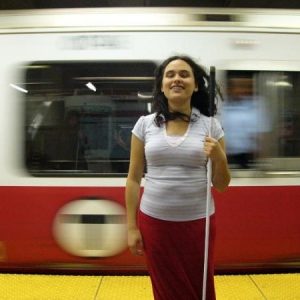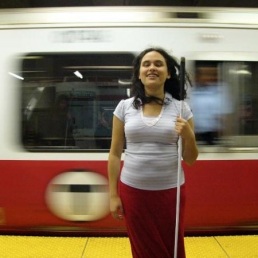Month: February 2023
What Is It Like to Experience Zero-Gravity?
Non-visual designer Lindsay Yazzolino shares her experience aboard the AstroAccess “AA2” Zero Gravity Flight
Listen to the audio interview or read the full transcript below.
Kelsey Perrett: Hi, I’m Kelsey Perrett with ARISA Lab. Today, I’m speaking with non-visual designer Lindsay Yazzolino. Lindsay is a consultant with ARISA Lab and the Eclipse Soundscapes: Citizen Science Project. She recently returned from a zero-gravity flight with AstroAccess, a project dedicated to promoting disability inclusion in space. Lindsay joined us to discuss what it’s like to experience zero gravity, how the crew’s experiments will impact the future of accessibility in space, and why it’s important to include people with disabilities in the design process from the start. And now, let’s hear from Lindsay.


Kelsey Perrett: Lindsay says she first heard about the opportunity with AstroAccess when she was presenting at the SciAccess conference in 2019.
Lindsay Yazzolino: So I was at this conference, and I met a whole bunch of cool people, among them Anna Voelker and Sheri Wells-Jensen, who were both organizers of this conference. And turns out, they also were both organizers of what would become AstroAccess. AstroAccess of courses is the organization that ran this really cool zero gravity flight that we’re talking about. So yeah, I found out about them through SciAccess and that’s how I knew to apply. I applied the first year that they were doing the first zero gravity flight, which was 2021. They were very clear that they wanted people who were really open about talking about their disabilities, and who are really passionate about creating accessibility in space travel, spaceflight, and all this stuff. So I applied the first year, and it was super competitive, and I didn’t get in. You know, it was really cool that there was so many qualified people that it would be this competitive. So then the next year, I applied again, and I got in. I was really excited, because I mean, zero gravity flight. I was just super curious, you know, what it would feel like to experience zero gravity. And of course, I believed in what the organization is doing. And, of course, I wanted to use my skills and my experience, and, whatever I can bring to help increase accessibility in space in spaceflight. So it was a combination of like, I want to help science and wow, I get to be in an airplane and fly around in zero gravity, because I love airplanes and I love like thrill seeking experiences. And so it was just like, a whole combination of of coolness. And a lot of people have tried to explain, people get asked, what does it feel like to be in zero gravity? And everyone’s like, it’s really hard to explain. So one of my sort of goals when I was doing this was to try and be able to explain it as best as I could. And specifically, of course, me being totally blind, I was experiencing it totally non-visually. And I remember the first that initial feeling of the floor just kind of disappearing, and being like, Oh crap, there’s no floor. Because my instinct was to find the floor, because you know when you’re on Earth, and you’re tossed up in the air, you know that you’re going to end up having to fall back down onto the floor. And usually that’s not a very comfortable thing to happen. But of course, I knew it was zero gravity. But still I felt that need to sort of test what it feels like to be in this place where the laws of gravity are different. So in a way, I sort of felt like a baby. That’s the best I can explain is like, because it was this whole kind of relearning what happens when you move in this new environment. But after a few parabolas, I was just like, Okay, this is really fun. And that that point I was, well, I had to do my my actual science experiments. But like, let’s face it, the really fun part, was being in zero gravity. Actually, what I realized, the best way to describe it for me, is in some ways, it felt like instead of me moving within the plane, it felt like the plane was moving around me. And it would sort of feel like being on a hamster wheel where like, whatever you were on was sort of under you, like you’re actually propelling it under you, as opposed to feeling like I was, you know, upside down on the ceiling or sideways. So it was a really interesting sensation and nothing like anything I’ve experienced before.
Kelsey Perrett: While on board, the AstroAccess crew conducted a variety of scientific experiments which were intended to advance Universal Design in space travel.
Lindsay Yazzolino: You know, I mean, it’s really cool to go into zero gravity, but of course, we were also doing experiments. And the idea of these experiments was to increase our knowledge of how we can make spaceflight accessible, how we can actually design, on a practical level, how we can design spacecraft and space stations and all these things to be accessible. So there was a group of us who were blind or low vision on the flight. And we worked on a project where we developed a set of tactile graphics to help people orient non-visually while they’re in zero gravity. A few of us actually went to New York a few times to visit the New York Public Library where there’s a whole accessibility program led by Chancey Fleet, and there’s a whole bunch of everything to make tactile graphics. So we had tactile graphics and embossers, we got the help of a couple people who are really expert designers. So they got to help us actually sketch out the graphics. We had all these tactile drawing boards. It was like a few blind people with tactile drawing tools, just collaborating, you know, brainstorming and coming up with ideas, just iterating on these designs, and coming up with the best designs that we could think of. So the most important thing we wanted to make sure people knew was which way is down, because if you think about it, you’re in zero gravity, you don’t know which way you’re facing, it’s really easy to get disoriented. And the idea is that you could reach out and touch any surface, whether it be walls or floor ceiling, and be able to feel which way is down. And then also, we had symbols to show which direction different emergency equipment was and also how far that equipment was, and whether it was on your same wall or across from you on the opposite wall. So this is a totally new system that we developed. And we wanted to do some initial testing to see how quickly and accurately people can read them while in zero gravity. So we set up a few of us with a whole set of test graphics where you had to read them. And during each parabola, you had to call out — we recorded people’s observations about what they thought they showed.
Kelsey Perrett: I asked Lindsay what was it like to work on a team that was intentionally inclusive of people with disabilities, and whether this experience changed the way she thought about herself or her career as a scientist.
Lindsay Yazzolino: I mean, it’s always nice when you work with a group of people where you don’t have to deal with people being really paternalistic, or being way too hovering, you know, hovering over you, or thinking people —blind people, people with other disabilities — can’t, you know, handle themselves or do certain things or need to be led by people without disabilities. Of course, I think you and I both know that that’s a huge problem when that does happen. I mean, on a functional level, it just meant we could get more done. We could actually design some of the experiments that we wanted to do, that we could test the things we wanted to test, and that we could experience zero gravity in a way where we weren’t being restricted unnecessarily. Because that is always a thing, you know, to think about. I know, the word empowering is overused, we use that word a lot. But it was in the sense that, you know, we are the researchers, right, like, we’re the scientists, we’re the researchers. And so it felt like, honestly, it just feels the way it should, you know, to be in a group where inclusion and participation is expected. Yeah, it just feels like the way it should be. It’s definitely shifted how I feel about the proximity of myself to space travel. Before, it always felt like the idea of going into space was one of those things that, like you said, everyone kind of dreams about at some point. But it didn’t feel like a reality exactly. It kind of felt like, oh, this is a thing that other people do. And not even just because of being blind, but just because it’s just the thing that other people did. Very few people get to do it. So I feel like now I do feel closer to that reality. I feel like, especially now that there’s a lot more commercial space travel happening, you know, the idea of me thinking of myself going into space feels a lot more conceivable than it did before. And of course, making it accessible is a big part of that. We’re just making what we can do our part to do is to prevent designers from, whether intentionally or not, just creating bad designs that don’t need to happen and unnecessarily excluding people from going to space. I do think that, you know, we have to see this as an ongoing thing. Like yes, we did this flight. Yes, it was awesome. But now there’s just a lot more work to be done. There’s a lot more science to be done. But it’s like, I feel like we’ve barely scratched the surface when it comes to starting to explore possible, you know, accessible features and inclusion in space travel, all this stuff. So this is like just the beginning. And I’m really looking forward to seeing how things progress and to being part of contributing to that. And I think that like we just need that we need everybody who can be part of, you know, who who can contribute their expertise and their knowledge, and their belief in us as people, you know, who can eventually go to space.
